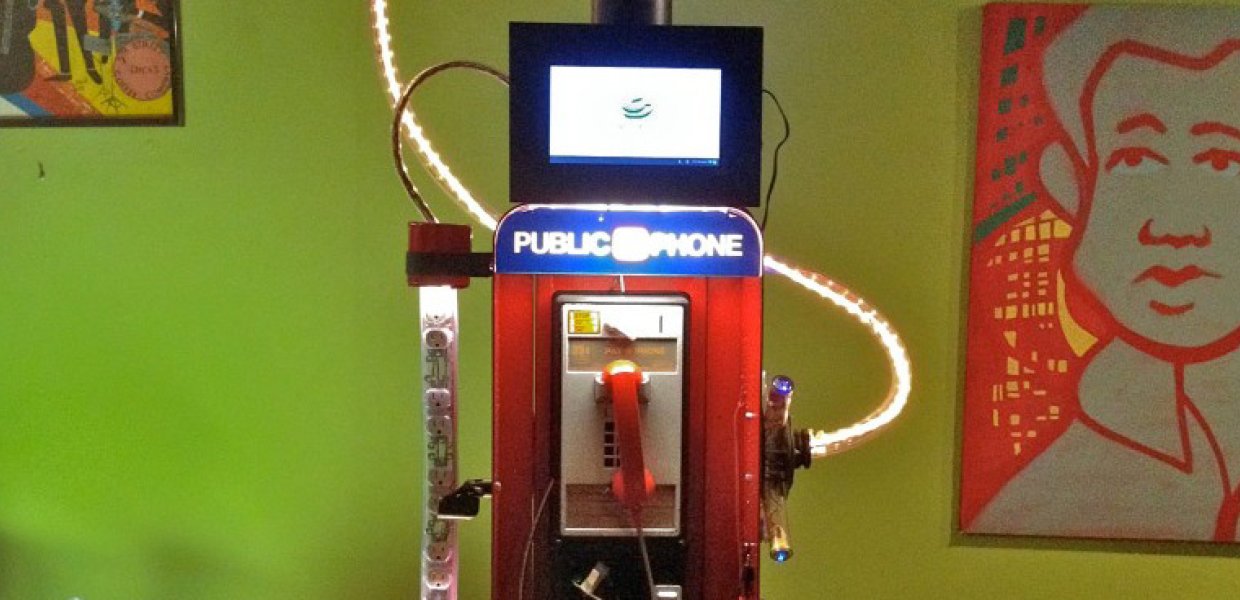Since 2012, Annenberg Professor Francois Bar, the Annenberg Innovation Lab and an entire community of artists, musicians and creators in Leimert Park have been working together to find ways to preserve the history and culture of the area, as well as promote civic engagement. Leimert Phone Company, a joint collaboration between USC Annenberg and local art space Kaos Network, has done so by repurposing old payphones.
USC Media Arts + Practice PhD candidate Karl Baumann explained that the symbolic Sankofa bird on the logo “flies to the future while constantly looking back towards the past.” Baumann, who helped found the project, said it embodies the “conceptual framework” for Leimert Phone Company. Over the last few years, a number of brainstorming workshops and classes have been held. The first was a five-week pilot period during which a group of USC students and Leimert Park residents met twice a week — once at USC Annenberg and once at Kaos Network. Kaos Network owner and Leimert Park community member Ben Caldwell said that he sees Kaos Network as a “community leader and liaison” with USC Annenberg in their “co-teaching relationship.”
“We are not simply bringing USC to the community, but providing means by which the community can communicate and collaborate,” said USC Annenberg PhD candidate Andrew Schrock. “In this way, Leimert [Phone Company] serves as a facilitator to amplify the voice of Leimert Park as a whole.” The collaboration continued with a spring 2013 test course at USC. Students and Leimert Park community members pitched prototypes through “concept videos.” Ideas included using the keypad to play local music, audio stories about the neighborhood and information about local art.
At the end of last year, the project unveiled its first physical prototype: Sankofa Red, a payphone that has been completely rewired on the inside and redecorated on the outside. Combining aspects of the earlier prototype ideas, it has a screen on the front, a speaker on the top, a microphone on one side and numerous outlets on the other side. Users can plug in Mp3 devices, do karaoke or pick up the phone to hear and record stories, as well as listen to the music of Leimert Park. “It’s kind of a whole art performance piece,” said Bar. The Sankofa Red operates through the “Raspberry Pi” — a circuit board created by Schrock specifically for the project. It connects to the keyboard of the phone and detects any action by the user. Sankofa Red resides in the Kaos Network space until sturdier versions of the prototype can be built, sponsored by local businesses and left on the street, but the prototype is brought out for community events, such as the monthly Art Walk.
It was also brought out for a event at Kaos Network held by Bar’s tactical media course (IML 404) through the Cinema school this past spring. The course introduced students to the project and had them develop prototypes using other types of public fixtures such as newspaper boxes and street benches. Students showcased their projects to gather support for a Leimert Park People St. plaza proposal that has since been approved by the Los Angeles Department of Transportation’s program that plans to transform under-used areas of Los Angeles into “active, vibrant, and accessible public space.”
Most recently, the Leimert Phone Company team also used their experimentation with payphones as the basis for an urban game called Sankofa Says. It was selected and presented at this year’s Indiecade — an annual festival for independent game designers held Oct. 9 and 10 in Culver City. The game used payphones to educate people on the history of Culver City. “Think of it as a treasure hunt which helps people meet each other and discover the place they’re in,” Bar said. Players registered for the game over the phone and were given a personalized code. They would then visit various places throughout Culver City where payphones resided.
At each place, players would pick up the payphone, enter their code and receive clues for a nearby activity. After completing the given task, they would use the payphone to answer trivia questions and receive points for correct answers. The game also incorporated group tasks that would require players to connect with one another.
Bar said that duplicating the game in Leimert Park is one of the project’s next goals. The other is to create additional prototypes, exploring new ideas for engaging the community. This will be the basis for a 2-unit, experimental class taught by Bar for seven weeks in the spring — ASCJ 420: Annenberg Collaboratory (HackLab). He hopes to attract students from all academic areas of USC to bring new perspectives to the project. Bar said that the collaboration between USC students and the Leimert Park community has been instrumental over the years. Students have benefited from getting to “discover the area around campus in a way that really allows them to understand culture and take advantage of all the opportunities they have here,” Bar said. Additionally, the community — made up of artists, musicians, and creators —have brought necessary skills to the project, skills that Bar’s students didn’t necessarily have.
In turn, USC students have brought ideas about communication, game design, and engineering to the community. Bar described it as creating a very diverse team that’s about to play together and work together towards a goal that’s, in this case, a little bit whimsical.” Caldwell echoed his sentiments toward their collaborative relationship, saying that “[Bar’s] team of people has been really good to work with and [he hopes] to continue work with those types of people to engage the community better.”









